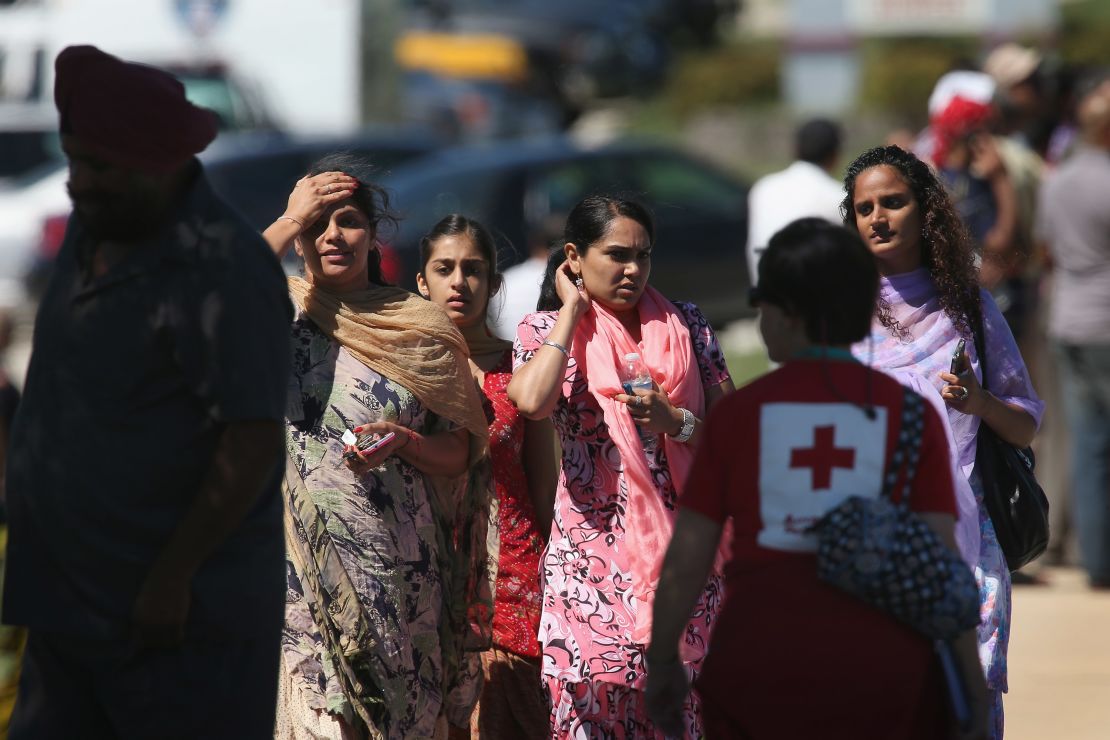Story highlights
A man who interviewed witnesses for police describes what they saw in Wisconsin
He says witnesses say the shooter was a bald, white man with a 9/11 tattoo
The gunman opened fire in the parking lot then in the temple's holy room, he says
Those inside sought cover in the pantry, with one woman even hiding in a closet
Women and children were busy inside the Sikh temple in suburban Milwaukee, preparing for their traditional Sunday feast. Religious leaders gathered in the building’s holy room, ahead of the hundreds set to arrive soon for the next service’s 11:30 a.m. start.
This peace was shattered, when what authorities believe was a lone gunman opened fire inside and outside the temple in Oak Creek, Wisconsin. By the time a police officer – after his colleague had been “ambushed” and shot multiple times – returned fire, the gunman and six others were dead, Oak Creek police Chief John Edwards said.
Police on Monday identified the gunman as Wade Michael Page, 40, an Army veteran.
FBI will investigate rampage as a ‘domestic terrorist-type incident’
Witnesses described the shooter as a bald white man, standing about 6 feet tall, wearing black pants and a white T-shirt – with a tattoo marking the September 11, 2001, terrorist attacks on the United States visible on one of his arms – said Kanwardeep Singh Kaleka, a temple member who worked with police as an interpreter, talking to witnesses after the attack.
The gunman entered the parking lot Sunday morning and soon opened fire, killing at least one person, Kaleka said.
The first person to see a shooter was a 10-year-old child, Amardeep Kaleka – whose father Satwant Singh Kaleka is president of the temple – told CNN affiliate WISN. (Kanwardeep Singh Kaleka and Amardeep Kaleka are related, with the latter noting that he has a large number of extended family in the temple.)
Soon thereafter, the shooter made his way into the temple building.
He headed toward its holy room and shot “mainly turbaned individuals” there, according to Kanwardeep Singh Kaleka. He said that the casualties he knew of were “the equivalent of priests,” including Kaleka’s uncle, who is one of the temple administrators.
Women in the kitchen who were preparing the upcoming meal heard the gunshots. The shooter burst in, but those inside the kitchen “were fortunate enough to basically duck down and dodge” the bullets, Kaleka said.
People did whatever they could to survive. Some managed to run to safety outside. Others sought refuge in the temple’s basement, while others huddled together tightly in the pantry.
The temple’s top priest spent about one in a half hours in a bathroom stall, after being told about the shooter by its president Satwant Singh Kaleka, he later told Justice Singh Khalsa.
“Everybody pretty much said they saw a couple of people laying on the floor, and a lot of people just heard gunshots,” said Khalsa, a temple member since the 1990s who helped translate witness accounts for authorities in Oak Creek.
Amardeep Kaleka said his mother hid in a closet, shutting off her phone whenever anyone walked by.
His father, meanwhile, got shot “multiple times” trying to tackle the gunman, the son. Amardeep Kaleka first learned of the fate of his father, who was being treated at an area hospital, in a phone call saying he was “on the ground … and he’s bleeding bad.”

By 10:30 a.m., 911 call after call had begun flooding into emergency dispatch at the Oak Creek police department, according to Brad Wentlandt, a police chief in neighboring Greenfield, Wisconsin, a spokesman on the case.
The showdown between the police officers and the gunman occurred some time thereafter, finally ending the bloodshed. Still, it took several more hours for authorities to thoroughly sweep the building and the surrounding area, checking for clues and signs of additional gunmen, as some witnesses had suspected.
Kanwardeep Singh Kaleka said temple members he’d talked to had never seen the gunman or had any idea who he was.
The violence is antithetical to the Sikh religion and its custom of, literally, opening its doors to people of all faiths.
“It’s really unfortunate that someone took advantage of this, the love that we try to give out,” he said. “It’s disgusting, to say the least, that people would do this.”
Sources name alleged gunman in Wisconsin temple shooting
“Shock” was a word several temple members used to describe their feelings after the shots had stopped, with the grief widespread given that everyone there knew everyone else well. There was also rampant confusion, with little known about the names of the dead or the whereabouts of the injured.
Still, the tight-knit Sikh community took solace in the fact that they had one another to lean on for support, nourishment and love. Even so, they solicited help from the outside, too, to make sense of the terror and recover from it.
“I want everybody out there, whoever is hearing this, we would really appreciate your prayers your positive support,” Amardeep Kaleka said. “We’re in a great time of need for that positive energy, so please send it.”
Sikhism, the world’s fifth most popular religion, is a monotheistic faith that believes in equality and service to others, Sikh officials say.
CNN’s Greg Botelho contributed to this report.








